/topics/groundwater-recharge
Groundwater Recharge
A sudy of the core of a riverine system and relevance of meltwater in river basin hydrology
Posted on 25 Jul, 2010 10:44 PMMy house is about 20 years old and is located in R T Nagar in Bangalore. In 1990, I had got a borewell dug. The Borewell is about 150 feet deep and has been giving me excellent quality water until about 2 years ago when I started noticing muddy water. The water that is pumped to an overhead tank contains fine particles of mud which tends to settle down in the overhead tank.
Artificial recharging of an unconfined aquifer with an injection well in Ghataprabha sub-basin– A research report by National Institute of Hydrology
Posted on 21 Jul, 2010 08:47 AMThe report deals with the artificial recharging of an unconfined aquifer with injection well in the Hukkeri taluka in Ghataprabha sub-basin of Krishna river. The Ghataprabha sub-basin of Krishna like most river basins of peninsular India has been facing groundwater development problems varying in nature and severity. It has got a wide spectrum of issues such as cases of failure of wells at several places on the one hand, while some areas becoming unfertile due to waterlogging.
Augmenting groundwater resources by artificial recharge: A case study - Kolwan valley - A report by ACWADAM
Posted on 19 Jul, 2010 04:45 PM This report by ACWADAM describes the results of a research study conducted under the DFID funded AGRAR project at the Kolwan site in Pune district of Maharashtra state in India. The research focused on studying the usefulness of artificial recharge to augment groundwater resources through watershed development.
This report by ACWADAM describes the results of a research study conducted under the DFID funded AGRAR project at the Kolwan site in Pune district of Maharashtra state in India. The research focused on studying the usefulness of artificial recharge to augment groundwater resources through watershed development.
An important criterion of the study was also to understand the impact of artificial recharge on already changing livelihoods in areas where watershed development was conducted on a large scale.
A study of saline freshwater interface phenomena in the Mahanadi delta region (Orissa)
Posted on 10 Jul, 2010 10:40 PM The subsurface aquifer systems in Mahanadi delta region in Orissa (India) is largely characterized by two groups of freshwater aquifer systems, both of which are prone to saline water mixing/migration with time and development:
The subsurface aquifer systems in Mahanadi delta region in Orissa (India) is largely characterized by two groups of freshwater aquifer systems, both of which are prone to saline water mixing/migration with time and development:
- The south western Mahanadi delta region is represented by unconfined to semi-confined freshwater aquifers underlained by brackish/saline aquifer systems with a diffusion boundary.
- The north eastern parts of Mahanadi delta is represented by deep freshwater confined aquifers overlained by brackish/saline water aquifers with aquitard/ aquiclude boundary.
Review of artificial recharge practices - A research report by National Institute of Hydrology
Posted on 30 Jun, 2010 10:42 PMThe report gives a reviewed summary of various developments in the field of artificial recharge of groundwater at national and international levels. Different methods of recharging have been discussed in detail with reference to their design criteria, application and economic feasibility. The report also provides the details of field application.
Soil moisture movement and recharge to groundwater using Tritium tagging techniques in Hardwar - A research report by National Institute of Hydrology
Posted on 29 Jun, 2010 08:27 PMThe study looks at soil moisture movement and recharge to groundwater using nuclear methods like tritium tagging. It estimates the recharge to groundwater due to monsoon rain and irrigation through the unsaturated porous media in case of cultivated and uncultivated fields.
Chasing a mirage: Water harvesting and artificial recharge in naturally water-scarce regions - An EPW paper
Posted on 11 Jun, 2010 12:39 PMThis paper refers to the recent plans by the Government of India to undertake artificial recharge of groundwater in over-exploited areas of the country to meet the demands for water and raises certain fundamental questions about the methods used for analysing the hydrological and economic impacts of the interventions.
Mazhapolima Participatory Well Recharge Programme - Concept Note and Process Document (2009)
Posted on 07 Jun, 2010 07:27 PM Mazhapolima is a community based well recharge programme, initiated by the Thrissur District Administration in collaboration with the Panchayat Raj Institutions in the District, and implemented by networking NGOs/CBOs, households, departments and agencies, research institutions, private sector and all other key stakeholders, who are either a water user or a water provider/planner.
Mazhapolima is a community based well recharge programme, initiated by the Thrissur District Administration in collaboration with the Panchayat Raj Institutions in the District, and implemented by networking NGOs/CBOs, households, departments and agencies, research institutions, private sector and all other key stakeholders, who are either a water user or a water provider/planner.
Diversity of approaches and implementation arrangements according to location specific needs centered on sustainable outcome and service levels are the underlying tenets of the programme. The programme envisages recharging of about 4.5 lakh open wells in the district to ensure sustainable access to water.
Ensuring safe drinking water through innovative technologies to eradicate fluorosis - Sachetana Project - Information manual by BIRDK and Govt of Karnataka
Posted on 05 May, 2010 05:31 PM This manual produced by BIRD-K and DRDPR (GoK) provides the details of the Sachetana project that aims to provide safe drinking water to fluorosis affected populations through the adoption of innovative technologies for rainwater harvesting and groundwater recharge.
This manual produced by BIRD-K and DRDPR (GoK) provides the details of the Sachetana project that aims to provide safe drinking water to fluorosis affected populations through the adoption of innovative technologies for rainwater harvesting and groundwater recharge.
The project is being implemented through the Gram Panchayats of 60 villages from 4 taluks among three districts of Karnataka state over a period of five years (2006-11).
The objectives of the project include:
- Provision of safe drinking water through innovative rain harvesting structures
- Recharge of groundwater through excavation of percolation ponds
- Recharge of existing bore wells and direct recharge of aquifers
- Awareness generation activities to promote sustainable management and management of water resources and water harvesting structures.
Estimation of replenishable groundwater resources of India and their status of utilization - A research paper by CGWB
Posted on 19 Apr, 2010 09:49 PMThe paper describes the methodology used in the groundwater resource estimation and the results of the latest country-wide assessment. In India, dynamic groundwater resources are estimated jointly by the Central Ground Water Board (CGWB) and State governments at periodic intervals. The latest estimates of dynamic resources are based on groundwater resource estimation methodology-1997 (commonly known as GEC-1997). These estimations are widely used in formulating various groundwater development and management plans. The paper also discusses future strategies on groundwater resource estimations.





